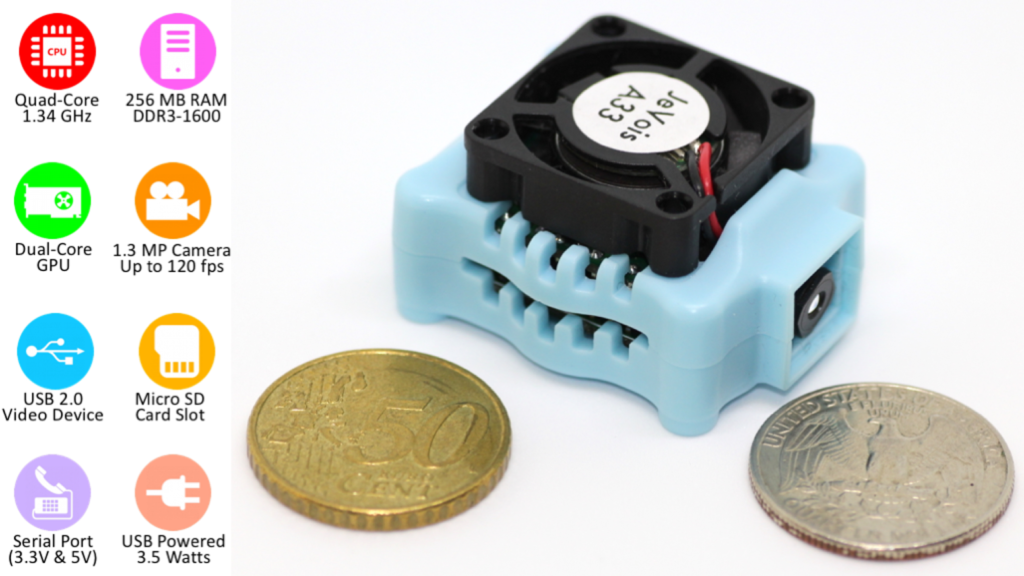
I’m a huge fan of the OpenMV cam, which is a very neat $65 integrated camera and processor with sophisticated built-in computer vision libraries, a Micopython interpreter, and a very slick IDE (a car powered entirely by it came in 2nd in the Thunderhill DIY Robocars race). Now there is a competitor on the block, Jevois, which offers even more power and a lower cost. I’ve now spent a week with it and can report back on how it compares.
In terms of form factor, it’s a bit smaller than OpenMV
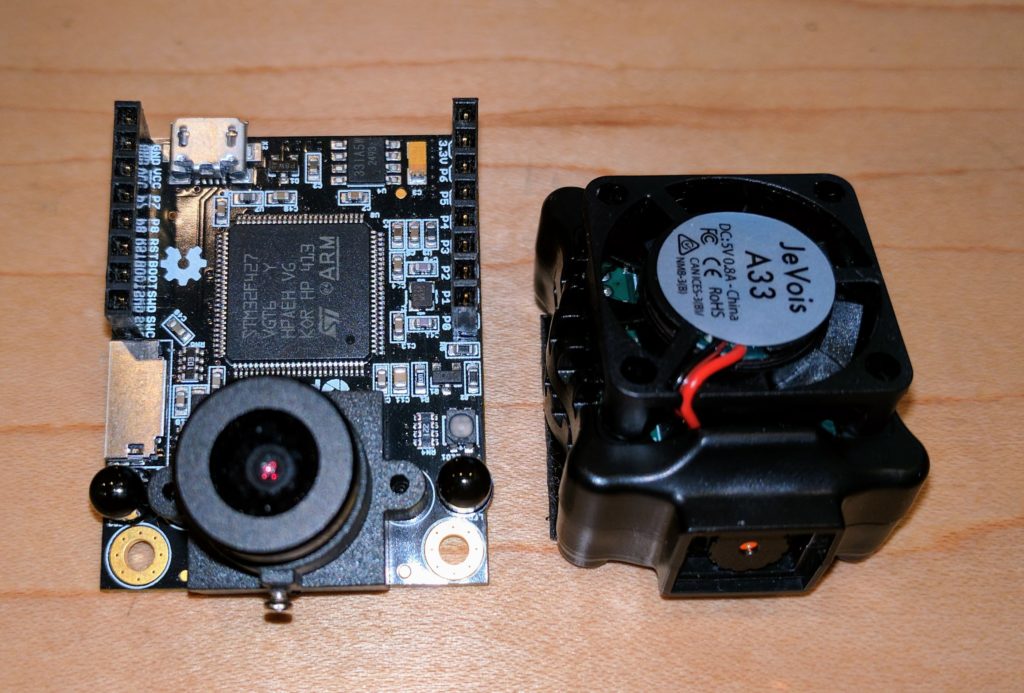
Here’s a quick feature comparison:
| OpenMV | Jevois | |
|---|---|---|
| Camera | 320x240, with good 2.8mm standard lens (can be switched to wide angle or IR) | 320x240, no removable lens |
| Processor | 216 Mhz M7 | 1.34 Ghz A7, with GPU |
| I/O | 3 PWM, Serial, I2C, 1 ADC, 1 DAC, USB | Serial, USB |
| Expansion boards | Wifi, LCD screen, proto board, thermal camera | (none) |
| OS | Micropython | Linux |
| Power consumption | 140 ma | 700-1,000 ma |
| IDE | QT Creator based custom IDE (Mac, Windows, Linux) | (none) |
| Memory | 512KB RAM, 1 MB flash, SD card | 256MB RAM, SD card |
| Price | $65 | $50 |
Both come with a full suite of standard computer vision libraries and examples. (OpenMV’s libraries are here and examples are here; Jevois’s libraries are here and examples are here). Both are well supported on the software side and have good communities. Jevois derives from the Jevois software framework that came out of academic work at USC. OpenMV is the work of small team of very smart computer vision experts, but benefits from the large Micropython community.
Basically, the Jevois board is more powerful, but the OpenMV board is a lot easier to use and more flexible, mostly due to its awesome IDE and native Micropython environment. Both can do our job of driving an autonomous car, so it’s just a question of which board is easier to develop on. Also, why would you get one of these instead of a RaspberryPi 3 and camera, which doesn’t cost much more?
For OpenMV, the reason to use it over RaspberryPi is simply that it’s easier. It’s got a great IDE that works over USB or Wifi that makes interactive use fun, it’s all in one board, and it can drive servos and read sensors without any additional add-on boards. Although the performance is not quite as good as RaspberryPi and it can’t run standard Linux packages like TensorFlow, the included CV libraries are well optimized to make the most of the hardware, and for basic computer vision the included libraries handle most of what you’ll want. (If you want to use neural networks, use the RaspberryPi — these are just computer vision boards).
For Jevois, the reason to use it over RaspberryPi is not as clear. It is potentially more powerful that a RasperrryPi at computer vision, thanks to the built-in GPU, but in practice it seems to perform about the same. But more importantly, it’s much harder to use. After spending a week getting it up and running, I think the only reason to use it over RaspberryPi is in cases where you need a very small, integrated package and can use the built-in modules pretty much as they are without much additional programming.
My testbed
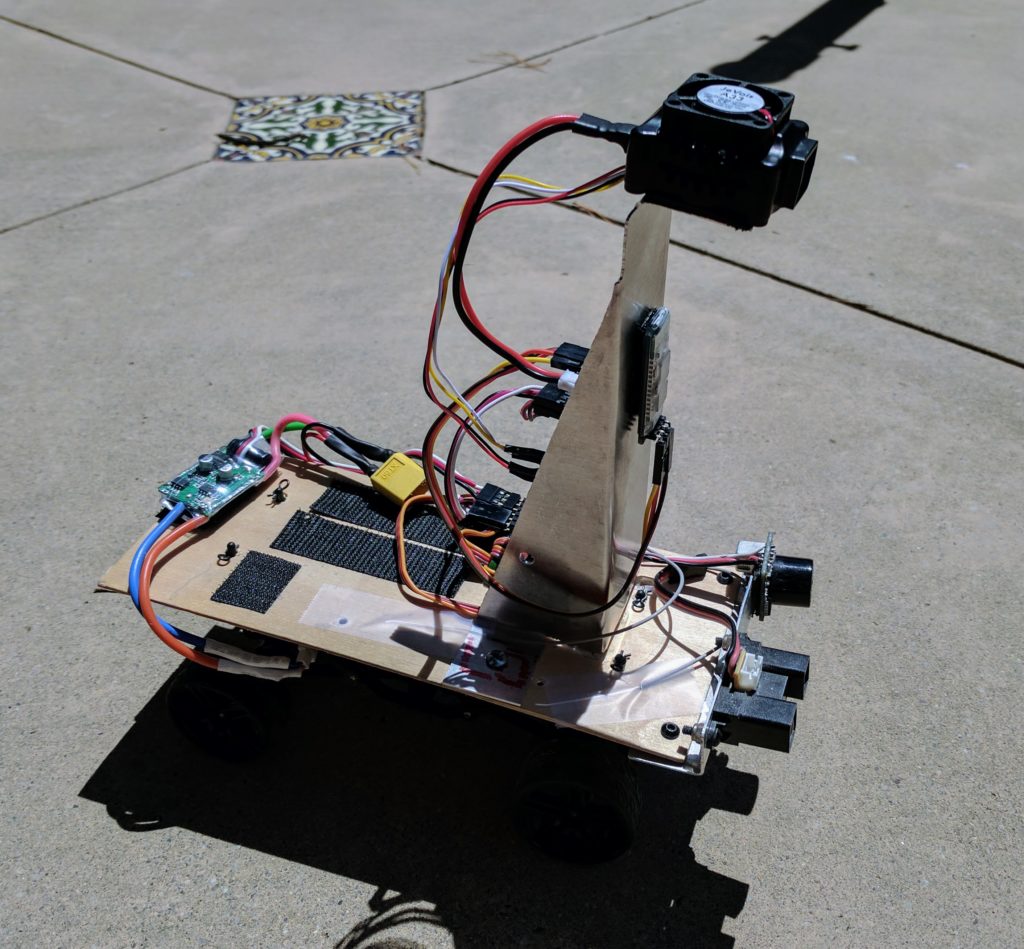
I built a small rover to use Jevois’s RoadNavigation function, using a cheap RC car chassis and some plywood and aluminum. The software uses a “vanishing point” algorithm to see the road ahead and keep the rover on it.

The module works very well when you plug it into a PC via USB and use a video app to test the computer vision modules, such as looking at a picture of a road. What’s much harder, however, is using it in the real world, in an embedded environment where you need to read the data, not just look at the cool on-screen lines.
To do that, you need to do a lot of work on both hardware and software:
Hardware:
You’ll need to get the Jevois talking to an Arduino, which will do the actual control of the car’s servos and motors. You can do that by adapting the included serial cable to connect to an Arduino. A tutorial is here, but in practice it’s a good bit harder than that. In my case, I used an Arduino Mini Pro running Software Serial to talk to the Jevois, so I could program and monitor the Arduino via a FTDI cable or Bluetooth bridge while it was communicating with the Jevois. I also created a custom PCB to attach the Arduino Mini to and break out pins for servos and sensors, although that’s not necessary if you use a regular Arduino and don’t mind a lot of wires hang off it. My Arduino code for this is here.
You’ll also need to power the Jevois via a Mini USB cable. I created my own using these connectors. The regular ESC that drives your car’s motor will not provide enough power for the JeVois, so I used a stand-alone power regulator like this one.
Here’s another shot of the completed car from the back, which shows the Arduino connection. You’ll note that it also has sonar and IR sensors at the front; those are not used now.
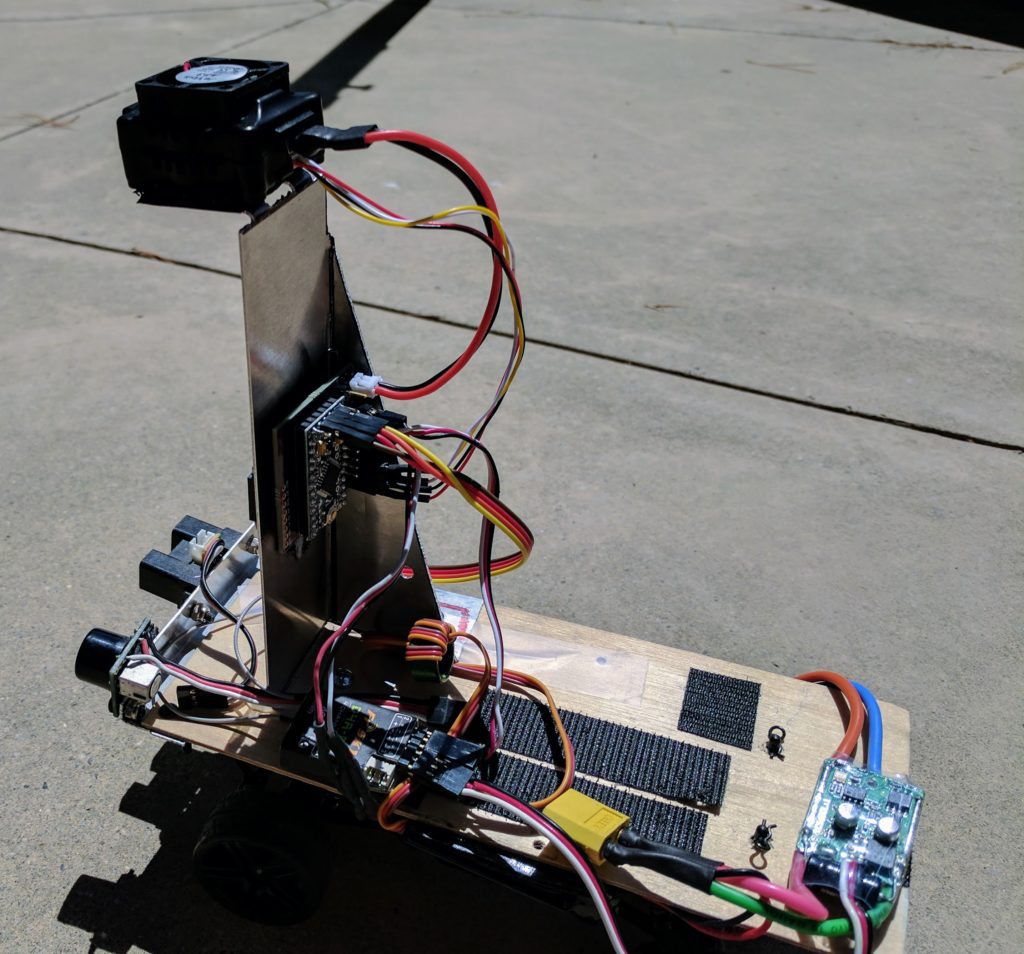
The hard part was the software. Basically, the way to use Jevois is primarily through modifying configuration files that are on the module’s SD card. The three necessary ones are here, but I’ll explain the key elements in the next section:
Initscript.cfg:
setmapping 1 # this selects the module that's assigned to Mode 1, which happens to be a video setting called "YUYV 320x240 30.0 fps" setpar serlog None # this tells it not to save a log file setpar serout Hard # this tells it to send data to the serial port streamon # this tells the module to start, even though the board is not connected to USB
Params.cfg:
serialdev=/dev/ttyS0 # this tells it to use the serial port serial:baudrate=38400 # this sets the baud rate to 38400 serial:linestyle=LF # this sets the line endings to a LF, which make it easier to parse
Videomappings.cfg:
NONE 0 0 0 YUYV 320 240 30.0 JeVois RoadNavigation # this is the key line. It assigns the 320x240 30fps video mode with no USB output to the RoadNavigation module
This last one is the most confusing, but the basics are that for arcane reasons involving not having a proper IDE and having relatively bare-bones video support, the only way you can command the Jevois module from a computer is by commanding changes in video mode. So all modes are mapped to a virtual video mode (confusingly, even if that’s not actually the video mode that it’s using), and the way to tell the board which mode you want it to boot up into is by assigning that module to the video mode number you’re calling in the Initscript.cfg, which runs on startup.
This all took forever to figure out, and needed a lot of help from the team in the forums. But now I’ve done it for you, so you just need to copy the files from here onto your SD card and it should work right out of the box.
In my opinion, this is too hard for beginners. The most perplexing thing about Jevois is that it runs Linux, but there’s no way to get to the Linux command line that I can find. If you could get to Linux via the USB cable (rather than just a weird command input parser that’s a lot like the old modem’s “AT” command set), you’d be able to script this powerful board properly and otherwise use modern programming tools. But as it is, this is a very fiddly matter of taking out the SD card and editing configuration files on a Linux PC, guessing at parameters, sticking it back into the Jevois board, powering it up and praying.
The Jevois software project is very mature and powerful, so I have no doubt that this more user-friendly exposure of its Linux heart and deep AI and CV libraries can be done. But right now the Jevois computer vision board feels like a cool demo (and an incredibly cheap computer vision computer) but not worth the hassle to use for real work when you can do so much more with a RaspberryPi in much less development time. Perhaps the next version will improve this.
[UPDATE: JeVois has now added the ability to read and write files on the SD card via USB, as well as Python 3.5 support, which is definitely a step in the right direction]
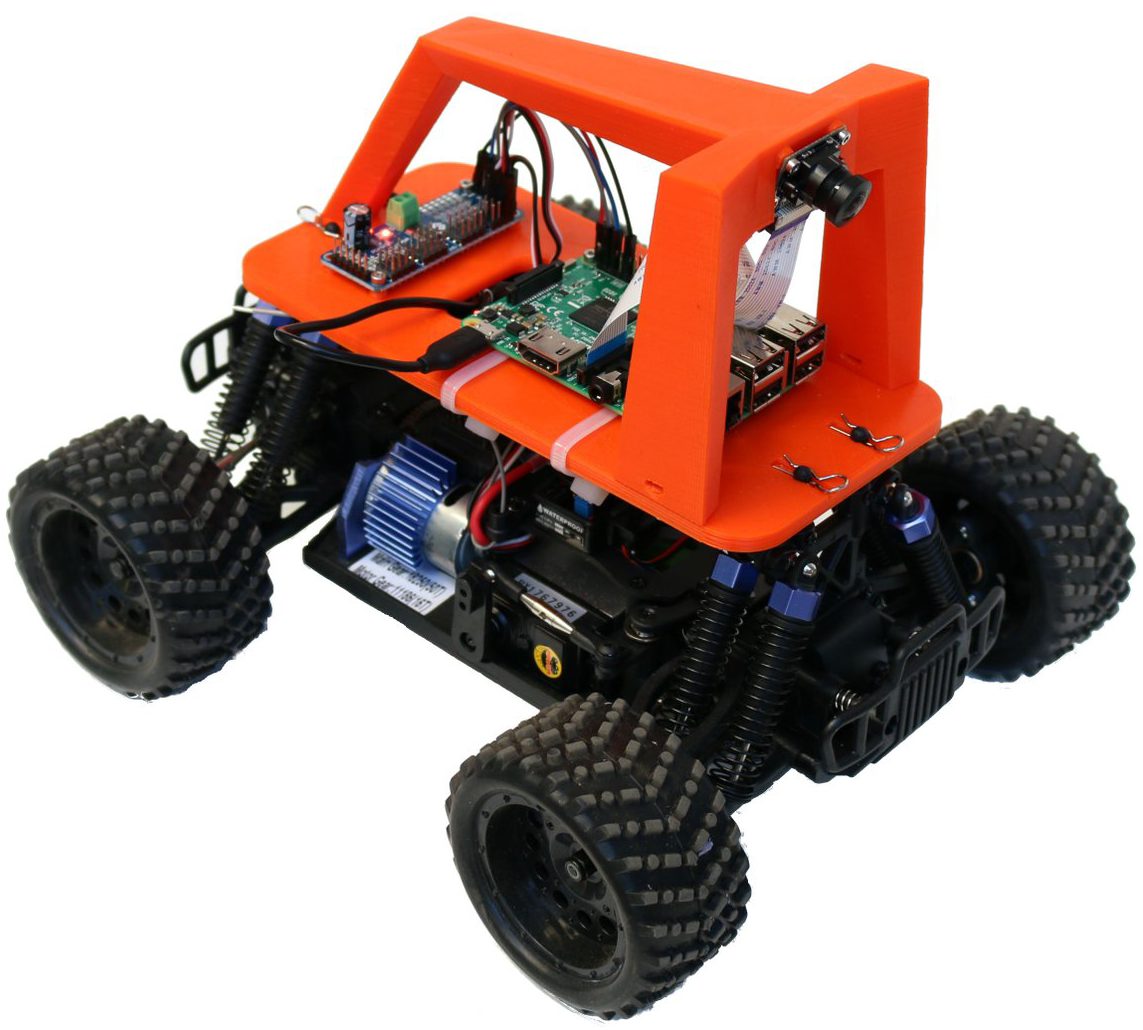
Hi,
thanks for your explanation.
I’m with you, the “documentation” are very louse and sooooo hard to figure out what must i prerpare to get my result :-/
I’s like a puzzle and without Google your are lost.
It would be nice the team has to writeup a popular “Handbook for beginners” to show up what nice features are integrated in these tiny Box and how to setup all the specific modules.
Cheers Andreas
If you want a linux console directly on the JeVois unit, put an empty file called “login” on the BOOT partition of the SD card. That’ll start a getty on the hardware serial port instead of the jevois daemon. The SDK even asks you explicitly if you want that when you build a new image. But you generally don’t need it, and if it’s the first thing you’re trying then you’ve missed the entire point of the design.
The JeVois SDK builds and runs modules natively on your host PC, so you’re meant to do most of the development and testing there. And that means you use whatever *proper* IDE you want. Proprietary hardware-specific IDE’s are *always* inferior, and if you spend more than a trivial amount of time you’ll quickly hit their limits.
Nice, but how exactly would you write a road following robot with OpenMV in micro python? I only see micro python code making trivial API calls to features that have been coded in C… Like, the python code for face detection (face_detection.py in the OpenMV examples) just calls img.find_features() which is then coded in C. Looking at the jevois source for RoadFinder.C, I see some quite complex multi threaded code that involves detecting and tracking a bunch of line segments, Hough accumulator, and more. Can this be done in micro python? And with 256 KILO-bytes of RAM I would say no way it can be done on OpenMV, period…
I will take editing 3 config files according to the posted jevois tutorials any day so i can get my robot on the road quick.
Merc: You’re right that the more sophisticated functions have to be coded in C ; the MicroPython is just the high-level language that calls them. Fortunately, the OpenMV team has both created a lot of those functions already, but also continues to release them optimized for the board. For example, the multi-threaded code that detects and tracks a bunch of line segments is now out here:
http://forums.openmv.io/viewtopic.php?p=1751#p1751
My point is not OpenMV vs JeVois in terms of power; it’s about the two in terms of ease of use. When it comes to power, JeVois has to compete with RaspberryPi 3, which is the more appropriate comparison.
Yeah looks like the OpenMV folks are now playing catch-up when people show them what jevois can already do out of the box. But getting those lines as you show in that link is still not the whole thing, how do I steer my robot in the end? What if I want to try a different approach to road detection? Likely i will need more C code. So I still don’t see your point about ease of use, your answer sounds like “ask the OpenMV folks to do it in C for you, whenever they get to it. Once they are done with the C that does everything, you can just make one API call in micro python and it will work! So much easier than writing an algo in C yourself.” On jevois, I write, compile, and debug my new ideas on my desktop first without having to wait for anyone, I use OpenCV which is very powerful and makes development of new algos relatively easy, then flash to SD and it just works in the camera. Highly rewarding! Are you just saying a GUI button with a hammer on it is far superior to typing ./jevois-build.sh?
The pi is a nice board but i have not seen any software framework for it that even remotely approaches what jevois offers (except of course compiling jevois on a pi). Camera support is terrible too. Why bother when jevois has it already figured out?
Actually, OpenMV is *much* easier in actually controlling the actual robot, thanks to the built-in PWM IO. For example, here’s the code that came in second in the Thunderhill Autonomous Car race (https://github.com/zlite/OpenMVrover/blob/master/pidrover.py). It’s not fancy, but it was done with no extra HW. Just the one board controlling the entire car.
As for the comparisons with RaspberryPi, I think you’re underestimating how mature the RPi work in this space is. Here’s the stack we use, which combines both OpenCV and TensorFlow to create an end-to-end neural network for a self-driving car.
https://docs.google.com/document/d/11IPqZcDcLTd2mtYaR5ONpDxFgL9Y1nMNTDvEarST8Wk/edit#heading=h.rqp8wbm837hn
Don’t get me wrong — I am very impressed with JeVois! But I run a robotics company and it still took me a week of SW and HW hacking to get the board to steer a car, much less actually complete a track. Please take this in the spirit it was intended: JeVois is amazing on the SW side, but the hardware implementation could be easier to use in practice in an embedded environment. As I said in my post, I’m betting you can do it!
Outstanding post ! These innovative methodologies will lead any business to the next level. Keep sharing. Thanks
Raspberry Pi Streaming Solutions